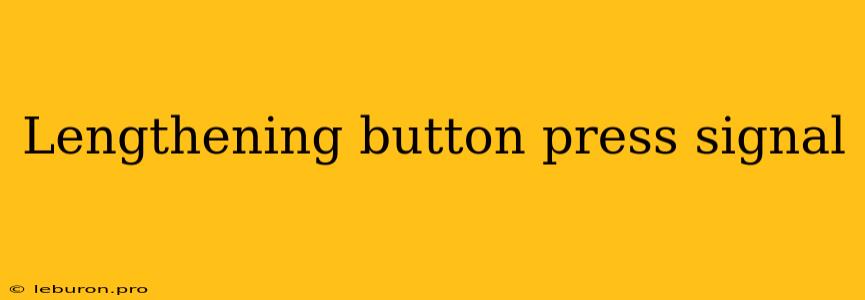In the realm of electronic devices and user interfaces, the duration of a button press, or "button hold," plays a crucial role in determining functionality. While a short press might trigger a simple action, a prolonged press, also known as a "long press," can activate more advanced features or initiate complex operations. This article delves into the intricacies of lengthening button press signals, exploring the techniques and considerations involved in enhancing the duration of button presses for improved user experience and functionality.
Understanding the Basics of Button Press Signals
At the core of any button press interaction lies a simple mechanism. When a button is pressed, it closes a circuit, generating an electrical signal that is interpreted by the device. This signal, known as a "button press signal," carries information about the button's state, including whether it's pressed, released, or held down. The duration of this signal, however, can vary depending on the specific implementation and the intended functionality.
Techniques for Lengthening Button Press Signals
Several techniques can be employed to lengthen the duration of button press signals, each with its own advantages and drawbacks:
1. Software-Based Solutions
Software-based solutions offer flexibility and adaptability in lengthening button press signals. These solutions typically involve modifying the software that interprets the button press signal, adjusting the duration threshold that differentiates a short press from a long press.
a) Debouncing Techniques
Debouncing is a crucial aspect of button press signal processing, particularly in scenarios involving mechanical buttons. When a button is pressed, the signal might fluctuate rapidly as the button makes and breaks contact, creating a series of short pulses. Debouncing algorithms help filter out these spurious signals, ensuring a clean and reliable button press signal.
b) Timer-Based Approaches
Timer-based approaches rely on the concept of setting a timer when a button press is detected. If the timer expires before the button is released, the signal is considered a short press. Conversely, if the timer expires after the button is released, it indicates a long press.
2. Hardware-Based Solutions
Hardware-based solutions directly manipulate the electrical signal generated by the button press. These approaches offer more direct control over signal duration, but they might require modifications to the physical button or circuit.
a) Capacitive Sensing
Capacitive sensing is a touch-based approach where a button is replaced with a capacitive touch sensor. These sensors detect changes in capacitance caused by proximity or contact with the user's finger. By adjusting the capacitance threshold, the duration of the button press signal can be modified.
b) Mechanical Modifications
In some cases, modifying the physical button itself can extend the duration of the signal. This might involve changing the spring tension or the contact mechanism to ensure a more prolonged contact between the button and its underlying circuitry.
Considerations for Lengthening Button Press Signals
While lengthening button press signals can enhance functionality, it's important to consider the following factors:
1. User Experience
The primary objective is to create a seamless and intuitive user experience. Modifying the button press duration should not lead to accidental activations or confusion. It's crucial to strike a balance between functionality and ease of use.
2. Compatibility
Compatibility with the underlying hardware and software is paramount. Modifications to button press signals should be carefully considered to ensure that they do not cause conflicts or interfere with other functionalities.
3. Signal Quality
Maintaining a clean and reliable button press signal is essential for accurate interpretation. Debouncing and other signal processing techniques are critical to eliminate spurious signals and ensure accurate signal durations.
Applications of Lengthened Button Press Signals
Lengthening button press signals find applications in various contexts, including:
1. Consumer Electronics
In smartphones, smartwatches, and other mobile devices, long presses are often used to access advanced features or perform context-sensitive actions, such as switching between apps or activating voice assistants.
2. Industrial Automation
In industrial settings, extended button presses can be used to initiate complex operations, such as starting or stopping machines or activating safety protocols.
3. Medical Devices
In medical devices, long presses might control vital parameters, adjust medication doses, or activate emergency functions.
Conclusion
Lengthening button press signals is a versatile technique that enhances the functionality and user experience of electronic devices. By employing software-based solutions, hardware-based modifications, or a combination of both, engineers can optimize button press durations to meet specific application requirements. Careful consideration of user experience, compatibility, and signal quality is crucial to ensure the success and reliability of these implementations. The ability to extend button press signals opens up new possibilities in user interface design, enabling more complex and intuitive interactions between users and their devices.
